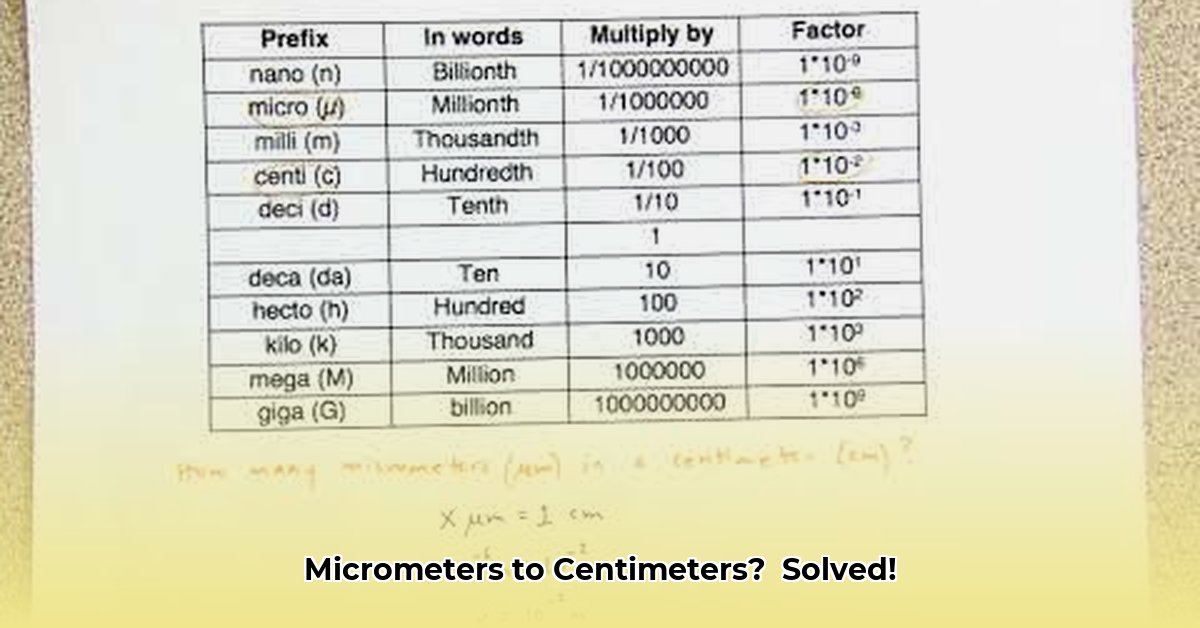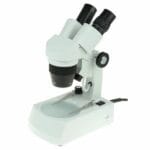Bridging the Microscopic and Macroscopic: Why Conversion Matters
Micrometers (µm) and centimeters (cm) are essential units of length used across diverse fields, from microscopy and engineering to nanotechnology and materials science. A micrometer, often called a micron, represents one-millionth of a meter (1 µm = 10-6 m). A centimeter, on the other hand, is one-hundredth of a meter (1 cm = 10-2 m). Converting between these units is crucial for understanding and manipulating structures ranging from the incredibly small to the readily observable. This conversion bridges the gap between the microscopic and macroscopic worlds, enabling accurate measurements, seamless communication, and precise comparisons across different scales. For converting larger units, see this helpful guide on meter to feet conversion.
Consider the width of a human hair, typically around 50-100 micrometers. This translates to just 0.005-0.01 centimeters, highlighting the significant difference in scale and reinforcing the need for reliable conversion methods. Accurate conversion ensures data integrity and facilitates meaningful comparisons across different measurement systems.
Mastering the Conversion: A Simple Formula and Step-by-Step Guide
The fundamental relationship between micrometers and centimeters is defined by the equation: 1 µm = 0.0001 cm. This implies that 1 cm is equivalent to 10,000 µm. This simple equation forms the basis for all micrometer to centimeter conversions.
Let’s illustrate the conversion process with a practical example: converting 3,750 µm to centimeters.
- Begin with the micrometer value: 3,750 µm
- Divide by 10,000: 3,750 µm / 10,000 = 0.375 cm
Therefore, 3,750 µm equals 0.375 cm. This straightforward method ensures consistent and accurate conversions.
To convert from centimeters to micrometers, simply multiply the centimeter value by 10,000. For example, 1.5 cm equals 1.5 cm * 10,000 = 15,000 µm.
Practical Applications: Where Micrometers Meet Centimeters in the Real World
The accurate conversion between micrometers and centimeters is indispensable in a wide range of scientific, engineering, and technological applications. In microelectronics, transistors and other components on integrated circuits are measured in micrometers, while the overall chip dimensions are often expressed in centimeters. Precise conversions are critical for design, manufacturing, and quality control.
In biological research, microscopes are used to measure cells and microorganisms in micrometers. Converting these measurements to centimeters can facilitate comparisons with larger biological structures or standardized reporting.
Nanotechnology, which deals with materials and structures at the nanoscale (1-100 nanometers), often requires converting between micrometers and centimeters, as 1 nanometer is equal to 0.001 µm.
Furthermore, in optics and photonics, wavelengths of light are commonly expressed in micrometers or nanometers, while lens dimensions and optical path lengths might be in centimeters. Accurate unit conversion is essential for calculations and simulations in these fields.
Avoiding Pitfalls: Ensuring Accuracy and Precision
While the conversion process is relatively simple, errors can occur. Common pitfalls include:
- Misplaced decimal points: A misplaced decimal can lead to significant errors, particularly when dealing with small values. Always double-check the position of the decimal point in your calculations.
- Incorrect conversion factor: Using the wrong conversion factor (e.g., multiplying instead of dividing) will result in an incorrect result. Ensure you are using the correct factor (1 µm = 0.0001 cm).
- Significant figures: Maintain consistency in significant figures throughout your calculations. The final result should not have more significant figures than the original measurement.
To minimize errors, use a calculator for conversions and verify your results with a reputable online unit converter. Always maintain awareness of significant figures and double-check your work.
Tools and Resources: Simplifying the Conversion Process
Several online unit converters provide a quick and efficient way to convert between micrometers and centimeters, reducing the risk of manual errors. These tools are readily accessible through a simple web search. While online converters are convenient, understanding the manual conversion process is fundamental for a deeper grasp of the relationship between these units.
Mastering Micrometer to Centimeter Conversion: A Foundational Skill
A solid understanding of micrometer to centimeter conversion is crucial for anyone working with measurements at different scales. Whether you are a scientist, engineer, technician, or student, this skill enables accurate data interpretation, effective communication, and precise manipulation of structures ranging from the microscopic to the macroscopic. By following the outlined steps, utilizing available resources, and remaining vigilant against potential errors, you can achieve consistent and reliable conversions, contributing to the accuracy and integrity of your work.
- Discover Life in a Medieval Castle: Beyond Battles & Banquets: Unveiling Daily Life - August 2, 2025
- Scipio Africanus: Hannibal’s Nemesis: Rise, Fall, and Legacy - August 2, 2025
- Unveiling Superorganisms: Are Ant Colonies One Mind? - August 2, 2025















